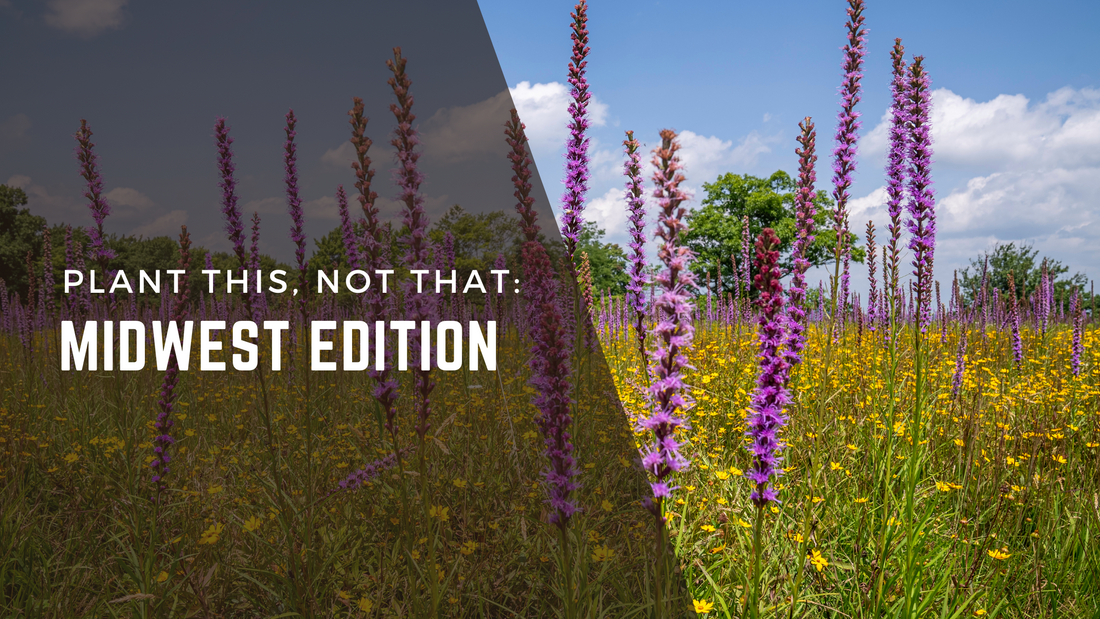Not all pretty plants are good for your garden, or the ecosystem. Many common landscape plants sold at big box stores are not native, offer little to no support for pollinators, and can even become invasive -- taking over and pushing out the beneficial native plants. But don't worry, there are gorgeous native plants that bring beauty, biodiversity, and incredible benefits to your Midwest landscape.
It's time to stop wasting space and time on those colorful but useless non-native plants. Instead, swap them out for native favorites that bees, butterflies, and hummingbirds actually love.
We have put together a “Plant this, Not That” guide to help you ditch the imposters, and plant what really counts – like Wild Bergamont over hybrid bee balm, Blazing Star over butterfly bush, and prairie drop seed over fountain grass.
Here are a few more simple swaps to get you started:
🌱 Plant: Wild Bergamot (Monarda fistulosa)
Not: Bee Balm ‘Jacob Cline’ or other hybrids
Why?
Hybrids like 'Jacob Cline' may look lush and vibrant, but they’ve been bred more for show than substance. Many of these varieties produce less nectar and/or pollen, reducing their value to native bees, hummingbirds, and butterflies. Wild Bergamot, a true Midwest native, blooms in summer with lavender-colored flowers and a spicy fragrance that pollinators love. It supports native bumble bees, hummingbird moths, and other beneficial insects. Plus, it’s drought-tolerant and thrives in less than perfect soils, making it ideal for sustainable landscaping.
🌱 Plant: Purple Prairie Clover (Dalea purpurea)
Not: Russian Sage (Perovskia atriplicifolia)
Why?
Russian sage is often used in sunny borders for its silvery leaves and lavender blooms, but it’s not native with limited pollinator support. It doesn’t provide the same quality or diversity of nectar and can crowd out native species. Purple prairie clover, in contrast, is a nitrogen-fixing native legume that supports both pollinators and soil health. Its purple flower spikes attract native bees, butterflies, and beetles while improving soil fertility for surrounding plants. It’s also deer-resistant and adds a fine-textured elegance to any prairie or pollinator garden.
🌱 Plant: Meadow Blazing Star (Liatris ligulistylis)
Not: Butterfly Bush (Buddleja davidii)
Why?
Despite its name, butterfly bush isn’t all it’s cracked up to be for butterflies—it doesn’t support caterpillars and can’t sustain the full life cycle of pollinators. In some areas, it can also become invasive and outcompete native plants. Meadow blazing star, on the other hand, is a monarch magnet and one of the best late-summer nectar sources for migrating butterflies. Its tall, spiky purple blooms are stunning in mass plantings and draw in a variety of native bees, skippers, and moths. As a true Midwest prairie plant, it thrives in well-drained soils and provides late-season color and pollinator support.
🌱 Plant: Pale Purple Coneflower (Echinacea pallida)
Not: Standard Coneflower Cultivars (e.g., ‘Cheyenne Spirit’, ‘Green Jewel’)
Why?
Fancy Echinacea hybrids may look impressive, but many are sterile or have altered flower forms that confuse pollinators. They often produce little nectar or viable seed, which reduces their ecological value. Native pale purple coneflower is more than just a pretty face—it provides nectar for bees and butterflies and seeds for finches and other birds in the fall. Its distinctive drooping petals and central cone create the perfect landing pad for pollinators. This deep-rooted prairie plant is drought-tolerant, deer-resistant, and thrives in full sun.
🌱 Plant: Prairie Dropseed (Sporobolus heterolepis)
Not: Fountain Grass (Pennisetum alopecuroides)
Why?
Fountain grass is a popular ornamental, but it’s non-native and often escapes its confines, spreading into natural areas where it disrupts native plant ecosystems. It doesn’t support pollinators or beneficial insects and offers no food for birds. Prairie dropseed is a fine-textured, fragrant native grass that forms graceful mounds and provides cover for ground-nesting birds and small wildlife. In the fall, its golden seed heads sway in the breeze and provide food for birds like sparrows and juncos. It’s low-maintenance, drought-resistant, and ideal for native plant borders or prairie-style landscapes.
🌳 Plant: Redbud Tree (Cercis canadensis)
Not: Ornamental Cherry Trees (e.g., Prunus serrulata)
Why?
Ornamental cherry trees are showy in spring but offer minimal value for native pollinators and birds. Many are sterile, meaning they don’t produce fruit or seeds that support wildlife, and they’re often short-lived. Eastern redbud, on the other hand, is a native understory tree that bursts into vibrant pink blooms each spring—an early food source for native bees. Its heart-shaped leaves provide shelter and food for dozens of caterpillar species, making it an essential tree for supporting butterflies and moths in Midwest ecosystems. Redbuds are drought-tolerant, low-maintenance, and perfect for smaller yards or woodland edges.
🌳 Plant: Bur Oak (Quercus macrocarpa)
Not: Bradford Pear (Pyrus calleryana)
Why?
Bradford pear trees have become a widespread problem across the Midwest—they’re invasive, brittle, and offer almost no support for local wildlife. They’re often planted for their uniform shape and white blooms, but they quickly spread into natural areas, displacing native plants and reducing biodiversity.
Bur oaks, in contrast, are ecological powerhouses. Just one mature oak can support over 500 species of caterpillars, providing essential food for birds and other wildlife. Their acorns feed mammals and birds alike, and their deeply lobed leaves are iconic in prairies and savannas. While slow-growing, bur oaks are long-lived and provide decades of habitat and beauty.
🌼 Want to Help Pollinators Thrive?
Choose natives that offer food, habitat, and seasonal interest—while keeping invasive species out of our wild spaces. Your choices can make a big difference.
Looking for Midwest-native plants in bulk? Book a free consultation with our team and we’ll help you find the right mix for your space.
This guide was inspired by Nativo TX’s Instagram series.

